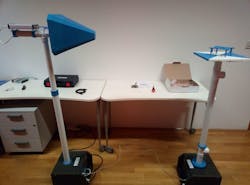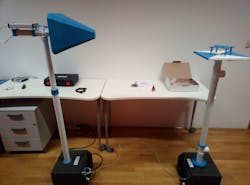Perform Cost-Effective Antenna Radiation Measurements (.PDF Download)
Antenna designers and researchers have often wished for better measurement tools to check their work. Even as computer-aided-engineering (CAE) simulation tools1-3 have improved over time, true validation of a design ultimately comes from fabricating and testing a prototype. Typical (or minimum) measurements of antenna characteristics include S-parameters and radiation patterns with further information on the antenna gain and efficiency, which usually calls for costly test equipment that may be outside the range of a designer’s budget. Fortunately, affordable antenna measurements are becoming more practical and readily available.
S-parameters can be measured in a limited fashion with a scalar network analyzer (SNA) and more completely with a vector network analyzer (VNA).4,5 Until recently, VNAs have been rather expensive test instruments, although smaller, less-costly units are emerging from several commercial suppliers.
Still, for full antenna characterization, some form of radiation pattern analyzer will also be needed and, fortunately, more affordable antenna radiation pattern analyzers have also entered the commercial market.6-8 For effective antenna radiation pattern measurements, the analyzer usually must be supported by an anechoic chamber and two antenna masts, for transmit and receive antennas, with the capability of rotating 360 deg.
Today, antenna designers can perform a wide range of antenna radiation measurements with the aid of a radiation measurement system (RMS) from the Netherlands-based firm MegiQ.9 Two versions of the RMS (Fig. 1) are available, for 0.6 to 4.0 GHz or 0.6 to 6.0 GHz. These frequency ranges cover many commercial wireless-communications applications.
1. This is how the MegiQ Radiation Measurement System (RMS) appears when it’s fully assembled and ready for testing antennas.
The RMS enables quick, easy measurements of three-dimensional (3D) radiation patterns (single-axis measurements are an option), as well as measurements of antenna gain, directivity, total efficiency, effective isotropic radiated power (EIRP), total radiated power (TRP), and field strength. Values can be measured for multiple frequencies during the single rotation of an antenna under test (AUT), simultaneously measuring horizontal (H) and vertical (V) radiated field components.

